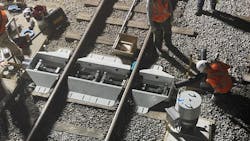WMATA will submit a revised service restoration plan to meet late summer return of 7000 series cars
The Washington Metropolitan Area Transit Authority (WMATA) has completed installation of the first automated inspection system that will allow the authority to inspect wheelsets of its 7000 series railcars in real time. Earlier this year, WMATA noted the trackbed technology would support continuous wheel measurements.
The authority said engineers will begin configuration, testing and commissioning of the system as it targets a return to service later this summer of the 7000 series railcars. WMATA plans to install six of these systems.
Automated wayside inspection systems (AWIS), such as the one installed by WMATA at College Park, Md., can monitor components, including wheels, using cameras and advanced algorithms to assess the components for potential issues or flaws.
About four hours after WMATA released information on the inspection system, the Washington Metrorail Safety Commission (WMSC), which is responsible for safety oversight of the Metrorail system, stated in a series of tweets that it had no technical objections to the 7000 Series Return to Service Plan that the authority submitted late in the afternoon on May 19. However, WMSC says use of AWIS units are not included in the plan.
Per WMSC’s Dec. 29 order, WMATA is required to submit any revisions to the return to service plan for a 14-day review before implementation occurs. WMATA says it will submit a new plan later that includes use of AWIS.
WMSC highlighted elements that are part of the current plan including:
- New and improved manual inspection tools;
- New and improved procedures with internal oversight and protections;
- Increased frequency of manual inspections, including daily inspection before the cars return to service (WMATA previously stated it takes approximately three hours to inspect the wheels of an eight-car train);
- Adjusted criteria for wheelset failures;
- New procedures to control the movement of railcars and ensure those put into service meet the plan’s requirements;
- Information technology updates to collect and validate data;
- New training on the improvements for enough people, who are also provided the needed tools, to implement the plan; and
- Data analysis including proactive use of specific data captured by the 7000 series cars.
7000 series sidelined since October
The 7000 series fleet was removed from service in mid-October following an Oct. 12, 2021, derailment. The National Transportation Safety Board (NTSB) found in its initial investigation a wheelset was found to be out of compliance with specifications.
NTSB continues its investigation and has not named a probable cause of the derailment. WMATA notes the investigation has not found evidence of failures related to maintenance or manufacturing of the equipment. MxV Rail experts (formerly Transportation Technology Center, Inc.) are conducting spin tests and ultrasonic tests that look at vibration and wheel performance at various speeds and conditions as part of a root cause analysis. The results of which will help guide WMATA on what combination of issues will need to be addressed.
About the Author

Mischa Wanek-Libman
Group Editorial Director
Mischa Wanek-Libman is director of communications with Transdev North America. She has more than 20 years of experience working in the transportation industry covering construction projects, engineering challenges, transit and rail operations and best practices.
Wanek-Libman has held top editorial positions at freight rail and public transportation business-to-business publications including as editor-in-chief and editorial director of Mass Transit from 2018-2024. She has been recognized for editorial excellence through her individual work, as well as for collaborative content.
She is an active member of the American Public Transportation Association's Marketing and Communications Committee and served 14 years as a Board Observer on the National Railroad Construction and Maintenance Association (NRC) Board of Directors.
She is a graduate of Drake University in Des Moines, Iowa, where she earned a Bachelor of Arts degree in Journalism and Mass Communication.
